100 Years of Federal Forestry
Agriculture Information Bulletin No. 402
|

|

|
|
1. The old and the new way to travel into the National Forest—pack
string and helicopter. (Bitterroot National Forest, Idaho). (F—496517)
|
Years Of Great Change, 1946-1960
Highlights
In 1946, engineers bounced a radar beam off the
moon—the first successful human-induced intrusion into outer space.
The same year, the Forest Service completed a postwar reappraisal of the
forest situation in the United States. Twelve years later, as the first
U.S. earth satellite, EXPLORER I, was launched into orbit, the Forest
Service issued the results of a nationwide Timber Resource Review. This
study was prepared over several years with the help of other Federal,
State, and private agencies. A new age of technological adventure,
economic growth, and international activity was at hand. The Forest
Service endeavored to insure that the conservation movement could adapt
to new times, in an age that increased the pressures on American forest
resources.
The times demanded that the Service share its
expertise, at home and abroad. Under the Cooperative Forest Management
Act of 1950, the Forest Service strengthened its cooperative programs to
give direct technical assistance to private forest land owners and
operators and to processors of forest products. From the mid-1940's, the
Forest Service began to play a continuing, important role in
international forestry activities and affairs. The Agency joined the
United Nations Food and Agriculture Organization in establishing a
permanent Forestry Committee during 1944-1946. American foresters played
major roles at the United Nations Scientific Conference on Conservation
and the Utilization of Resources at Lake Success, New York (1949), and
at the Inter-American Conference on Conservation of Renewable Natural
Resources in Denver, Colorado (1948). In 1960, the Forest Service hosted
the Fifth World Forestry Congress in Seattle, Washington. The Congress
had as its theme, "Multiple Use of Forest Lands," and participants
included 2,000 representatives of 68 countries and 9 international
organizations.
In 1953, the Forest Service was given the job of
managing some 7 million acres of "land utilization project" areas
acquired by the Federal Government during the depression years of the
1930's. Some of these areas, renamed National Grasslands, were absorbed
into the National Forest System in 1960, to be managed for multiple use
and sustained yield as the National Forests are. Congress amended the
mining laws in 1955 to curtail abuses which had interfered with
management of the National Forests.
Recreational demands on the forests increased, and in
1957 the Forest Service launched Operation Outdoors. The 5-year program
was designed to improve and expand the recreation facilities in the
National Forests to meet the demands.
In 1959, the Secretary of Agriculture submitted to
the Congress a "Program for the National Forests," a long-range plan
calling for further improvement and development of these public forests.
This was a follow-up to the Timber Resource Review findings of 1958
which indicated that the Nation needed to grow more timber if expected
future requirements were to be satisfied.
Forest Service Research also changed to meet the new
needs. In 1946, a system of multifunctional research centers was
established, each center with its own assigned geographic territory and
a program aimed at solving the primary local forest and range problems.
In 1953, the Forest Service assumed charge of research and control work
on forest insects and diseases from other agencies of the Department of
Agriculture. Then, in 1959, a major Servicewide reorganization of
research focused on the basic unit, the research center, which became a
functional research project. The result was a strengthening of the
scientific research capabilities in every field.
A memorable ending to an exciting period of great
changes in Forest Service outlook, and National Forest activities in
particular, came in 1960 with the signing by President Dwight D.
Eisenhower of the Multiple Use-Sustained Yield Act. This legislation
specifies that the National Forests shall be administered for outdoor
recreation, range, timber, watershed, and wildlife and fish
purposes—in such combination and in such a manner that they will
best meet and best serve human needs. In effect, 55 years after
Secretary of Agriculture "Tama Jim" Wilson stated the basic precepts,
the Congress affirmed national policy to "develop and administer the
renewable surface resources of the National Forests for multiple use and
sustained yield of their several products and services obtained
therefrom."
Throughout its history, the Forest Service has had to
deal with clashes of interest as various individuals and groups competed
for a share of the National Forest resources. With the passing of time,
as the population of our country and the demands of our people for
natural resources have dramatically increased, conflicts change but
still continue to arise. This is a fact of life for the Forest Service
as it continually works to balance the competition for the resources in
order to meet the many present needs and allow enough for the future. In
the Multiple Use-Sustained Yield Act, it received a fundamental charter
to insure that the basic purpose of forest conservation would remain
valid in times of rapid technological and economic change. The forests
would be used—and remain capable of supporting many uses—in
perpetuity.
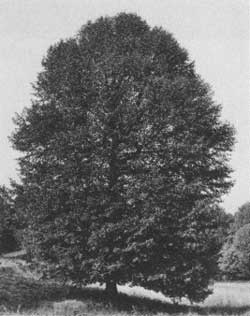
(F—91993)
1946-1960

|
|
1 (top). The offices of the Chief Forester and his staff
were moved into the South Building (center) of the U.S. Department of
Agriculture in 1940. Here are located the national administration, planning,
and policy-making headquarters for the Forest Service, a strongly
decentralized agency. (F—447583) 2 (bottom). In 1949,
President Harry S Truman honored the memory of the first Chief of
the Forest Service, changing the name of the Columbia National Forest
in Washington State to the Gifford Pinchot National Forest. Grandson
Gifford Pinchot III looked on as the President signed the name-change
proclamation. (F—455275)
|
Sidelights (1946-1960)
The Third American Forest Congress was held in
Washington, D.C., in 1946, under the auspices of the American Forestry
Association. This meeting and the discussions of many interested people
from the forest industries, labor, Federal and State forestry agencies,
and various civic and conservation agencies resulted in a "Program for
American Forestry." This program called for expanded efforts in
protecting forest and watershed lands from wildfires, insects, and
diseases; for more research; for better timber cutting practices; and
for increased technical help to small woodland owners.
In 1954, the first pulpmill in Alaska began
operations, the result of many years of Forest Service effort to bring
about development of a pulp and paper industry in southeastern Alaska.
The basis for this development was a sustained supply of wood from
National Forest lands.
Dropping water and chemicals on active forest fires
was successfully carried out for the first time in 1956. The Forest
Service and cooperating California agencies used specially designed air
tankers for the pioneering efforts which were destined to prove
tremendously effective as a firefighting tool in years to come.
The Soil Bank program came into being as one of the
provisions of the Agricultural Act of 1956. Farmers were offered
financial assistance in converting general cropland to conservation
uses, including the planting of trees.
The year 1955 marked the 50th anniversary of the
transfer of the Forest Reserves to the U.S. Department of Agriculture
and the renaming of its Bureau of Forestry as the Forest Service. Many
of the Agency's earliest members or "alumni" were still living. They
recalled the early struggles of the Bureau to promote the then rather
novel idea of managing forest lands for continuous production and, in
the face of considerable misunderstanding and antagonism, to protect and
develop the public forests for perpetual use.

|
|
1 (top). Cooperation—State and Private Forestry. Here
State and Federal foresters get together to study log grading procedures
in Texas in 1951. (F—464466) 2 (bottom). Writer and poet laureate
of South Carolina, Archibald Rutledge, owner of the famous 2000-acre Hampton
Plantation, discusses forestry matters with C.G. Herrick, Assistant Supervisor
of the South Carolina (Francis Marion and Sumter) National Forests (1950). (F—465024)
|
1946-1960

|
|
1 (top left). Forest Ranger showing a Girl Scout patrol
the proper use of compass and map in wilderness camping. This 1960
Girl Scout All-States Encampment took place in the Deschutes National
Forest, Oregon. (F—497193) 2 (middle left). Research . . . Pilot
Joe Soloy and Elmer Shaw, as guide, explore boundaries of a 40-acre
experimental seeding area in the Olympic National Forest, Washington
(1952). (F—474663) 3 (bottom left). Ranger Grant Williams checks
enclosure set up by researchers for a grass-growing experiment in the
Dixie National Forest, Utah (1953). (F—474934) 4 (top right).
Reforestation . . . Proper planting is essential to the success of
western white pine seedlings being planted on the Kaniksu National
Forest, Idaho (1966). (F—515013) 5 (middle right). Trees injured
by wind in Oregon during a heavy blowdown. (F—471466) 6 (bottom
right). Grazing sheep on the Apache National Forest, Arizona (1960).
(F—497887)
|
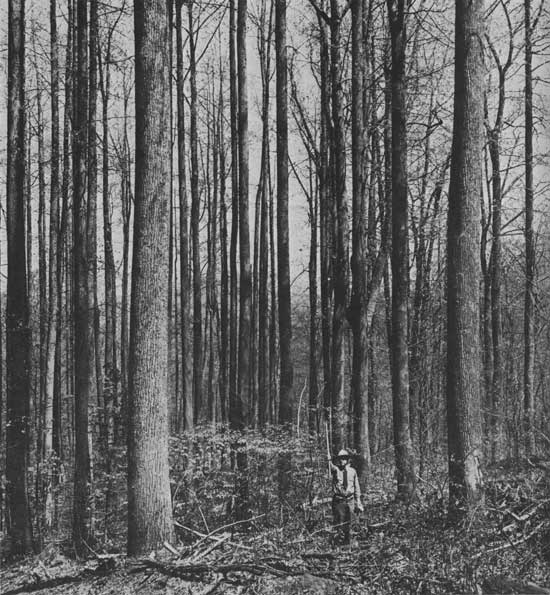
|
|
1. Resource Management—Timber. Ranger Ted Seely measures
the height of one of the tall yellow poplars on the Chattahoochee National
Forest, Georgia, in 1949. (F—458499)
|

|
|
1 (top left). Forest Service scaler measures logs
in a raft at the Ketchikan Pulp Co. mill in the South Tongass
National Forest, Alaska (1957). (F—485140) 2 (top right). Cartographic Aide
Fred Kyle uses a tellurometer, brought in by helicopter, to make
distance measurements on the Flathead National Forest, Montana
(1960). (F—496196) 3 (bottom). Engineering—Surveys. Forest Engineer
Bob Toney (second from right) briefs the crew surveying the
right-of-way for a new road to an overlook point from which visitors
can better enjoy the view of Mendenhall Glacier, Tongass National
Forest, Alaska (1958). (F—486815)
|
"Forest conservation involves much more than
the growing of crops on forest lands to supply raw material in one form or another for
an ever-growing list of uses. Forestry must be coupled with the social and economic
welfare of rural communities, especially in regions primarily dependent upon forest
industries. Improving forest productivity should mean a great deal to rural America
in augmenting the income of farm folk, maintaining pay rolls in small communities,
and sustaining the tax base to support local government functions."
Lyle F. Watts (1943-1952)

|
|
1 (top left). Lyle F. Watts, Chief of the Forest Service, 1943-1942. (Drawing by Rudolph Wendelin)
2 (top right). Planting for the future! In 1938, Mr. Tipton was a CCC enrollee when
he helped plant shortleaf pine trees in a plantation within the Clark National Forest,
Missouri. Twenty years later he, as a pulp logging operator, purchased the timber he
helped plant. The sale of pulpwood was the first commercial cutting in the plantation. (F—488405)
3 (bottom right). "Should auld acquaintance be forgot . . ." To celebrate this first
sale in 1958, former CCC Camp Bradley members gathered at the planting area. From
left to right: First Sergeant Charles Hawk, now Ripley County Sheriff; second man is
unidentified; District Ranger Frank Kopecky; District Ranger, at the time of the planting,
Harley Thomas; Camp Commander Bill Kolbert, hotel owner; and Camp Foreman Randolph
Barrett, later with the Missouri Conservation Department. (F—488382)
|

|
|
1 (top). In 1952, on the Chipola Experimental Forest, Florida, researchers
studied different methods of site preparation for planting slash and longleaf pine seedlings.
Various mechanical treatments of the soil and chemical control of the undesirable plant
growth present were used as part of the experimentation. (F—483907) 2 (bottom). Prescribed burning
was used in 1958 in stands of loblolly pine in the Santee Experimental Forest, South
Carolina, to reduce the amount of fuel present. (Prescribed burning remains a common
practice in forests and woodlands of the South where the grass and other undergrowth,
commonly termed the "rough," can accumulate to dangerous fire potential limits.) (F—489082)
|

|
|
The Cooperative State and Private Forestry activities of the
Forest Service grew in numbers and variety after World War II. Reforestation
programs became major joint cooperative efforts. 1 (top left). Forest Service
crew planting Ponderosa pine on the Escudilla Mountain, Arizona, burn of June
1951. The reforestation work was taking place in August 1957. (F—482968) 2 (bottom).
Trees on the slope, row crops in the valley—an example of good land use.
The farmers who owned this land cooperated with the YLT Project in planting
80,000 trees over several years (Mississippi 1954). (F—476613) 3 (top right). The Yazoo-Little
Tallahatchie (YLT) Flood Prevention project in Mississippi, a cooperative activity
of the Forest Service, served as an excellent educational effort over the years
in bringing about improved land use. In one 1954 project, Boy Scouts planted
trees on severely eroded land in northern Mississippi. They were brought to the
site from Memphis, Tennessee, as part of the conservation program of private
concerns and State and Federal agencies, including the Forest Service.
(F—476612)
|

|
|
Fast-growing pines in the South contribute to a major pulp and paper
industry which utilizes, in many instances, processes developed by Forest Service
scientists at the Forest Products Laboratory in Madison, Wisconsin. 1 (top left).
Pulpwood en route to a plant in Jones County, Mississippi (1948). (F—451320) 2 (bottom).
Unloading at a pulpmill in Kingsport, Tennesee (1957). (F—486278) 3 (top right). Chips en
route to first step in the sulfate papermaking process in Jefferson County,
Arkansas (1960). (F—497021)
|

|
|
On the National Forests, timber is managed on a sustained yield
basis to produce a continuous supply of raw material to help meet the Nation's
economic demands. These public forest properties represent a vital reservoir
of trees destined for commercial use as well as for watershed protection, for
recreational purposes, and for wildlife areas. 1 (top). Typical managed timber
stands in the South during this period included shortleaf pine in South
Carolina (1957) . . . (F—486648) 2 (bottom left). Longleaf pine in Georgia (1947) . . . (F—351079)
3 (bottom right). Mixed hardwoods in eastern Arkansas (1960) . . . (F—498335)
|

|
|
1. A virgin stand of Delta hardwoods (redgum) in
Mississippi (1948). (F—451408)
|

|
|
1 (top left). In forestry terminology, this is "clearcutting
by staggered settings" in old-growth Douglas-fir on the Willamette National
Forest, Oregon, in 1953. This logging method is considered desirable for
the continued production of this and certain other species. It is designed
to obtain full crop utilization and to provide for regenerating the cutover
area with seed from the adjacent trees, artificial seeding, or planting.
Through the years, clearcutting has aroused considerable opposition, largely
from those who decry the temporary disrupted appearance of the cutover area
before new tree growth becomes established. (F—478288) 2 (top right). An area on the
Willamette National Forest being clearcut in 1957. (F—483403) 3 (bottom left). The same
area 10 years later is covered with a healthy stand of Douglas-fir. (F—517971)
4 (middle right). Skidding logs on the Willamette National Forest, Oregon.
(F—515858)
|

|
|
1 (top). This large Sitka spruce was ready for harvesting.
Note the springboard used by the "faller" as a place to work from above
the butt swell of the tree (South Tongass National Forest, Alaska, 1957). (F—485165)
2 (bottom left). Forest thinnings make fine Christmas trees (Olympic
National Forest, Washington, 1950). (F—463486) 3 (bottom right). The St. Regis Paper
Company drivers worked from dawn to dusk an entire day to break up a log
jam that had about 1-1/2 million board feet of logs tied up in Machias
River (Washington County, Maine, April 1951). (F—465406)
|

|
|
(F—478147)
|
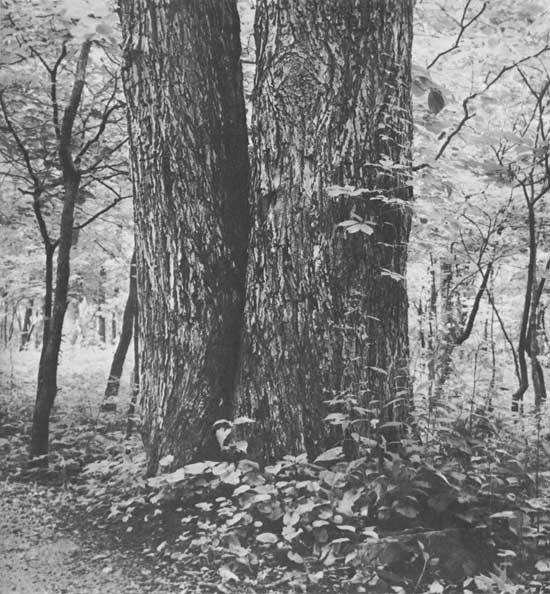
|
|
(F—399405)
|
". . . Farm woodland and other small
private forests hold the key to this Nation's future timber supply. These lands,
generally in poor condition, are the greatest potential source of wood fiber.
Producing more wood on these lands requires concerted effort by State and Federal
foresters, forest industries, and the landowners."
Richard E. McArdle (1952-1962)
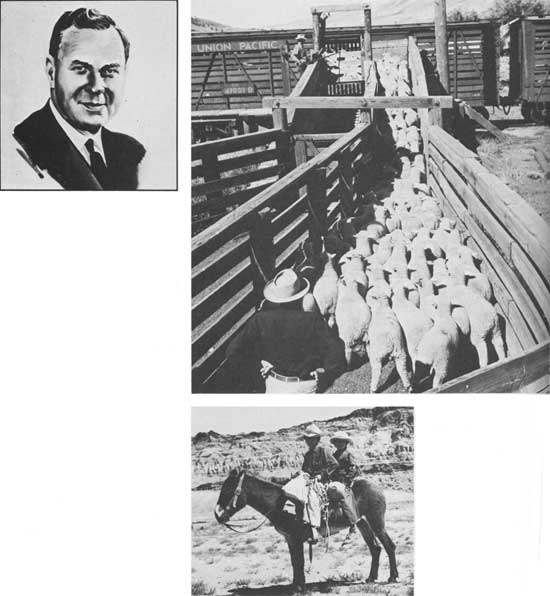
|
|
1 (top left). Richard E. McArdle, Chief of the Forest Service,
1952-62. Forage in the National Forest System has always been an essential crop
maintained for harvest each year, under paid permit, by thousands of head of
livestock. This constitutes an important contribution to the Nation's food basket
as well as to the local ranchers, farmers, and communities. Countless wild
creatures also depend upon public rangelands for their food. (Drawing by Rudolph Wendelin) 2 (top right).
These lambs in prime condition and averaging 95 lbs. each after a summer in the
high mountain meadows of the Targhee National Forest, Idaho, were on their way
to market in Los Angeles (1951). (F—468318) 3 (bottom right). Navajo Indian boys herding
sheep in the Kaibab National Forest, Arizona. The round sack contained a
watermelon (1946). (F—443989)
|

|
|
1 (top left). Muddy Meadows, in the shadow of Mount Adams, Gifford
Pinchot National Forest, Washington (circa 1950). (F—456976) 2 (middle left). Sparks Lake
Meadow, South Sister Mountain in the background, Deschutes National Forest,
Oregon (1959). (F—492765) 3 (bottom left). A key range management research study in the
late 1940's and early 1950's helped determine methods to restore rundown land
to grass production, and the proper range management practices to follow after
restoration. Much of this work was done in the Manitou Park Experimental
Range on the Pike National Forest, Colorado (1951 photo). (F—468429) 4 (top right).
Forest Service programs and activities are carried out with the cooperation
of State fish and game agencies. Here, in 1959, a Game Warden of the North
Carolina State Wildlife Resources Commission is shown stocking fish in the
Davidson River on the Pisgah National Forest. (F—492578)
|

|
|
1. National Forest road in Hocking County, Ohio. (F—502972)
|

|
|
It takes a vast transportation system of forest roads
and trails in the National Forests to provide access for recreation,
hunting and fishing, timber management and harvest operations, as well
as for grazing, mining, control of fires, insects and diseases, and forest
administration generally. 1 (top). Snow clearing on a National Forest
road (Angels Crest Highway, Angeles National Forest, California, November
1946). (F—443046) 2 (middle left). Through the years, road and trail construction
has been a major Forest Service engineering effort (Ochoco National
Forest, Oregon, 1951). (F—468934) 3 (bottom left). The camera teed off in 1960 on
this unusual special use area (open to the public) in the cool mountains
of the Sitgreaves National Forest, Arizona. (F—494337) 4 (bottom right). Various
special uses have been permitted in the National Forest System, providing
public benefits while conforming to multiple-use principles in the management
of these public properties (Heart's Content Observatory, Allegheny
National Forest, Pennsylvania, 1958). (F—488948)
|

|
|
From a humble, but daring, experimental start in the
Chelan (now Okanogan) National Forest, Washington, in 1938. Forest
Service smokejumping activities progressed rapidly in the early 1940's
and thereafter into a full-fledged segment of the total forest fire-control
program. The smokejumping program has grown from just a few crews of
relatively untrained men jumping to fires from Ford Tri-motor and
Travelair planes to today's hundreds of well-trained jumpers in modern
aircraft playing a major role in battling forest fires. Through 1975,
nearly 129,000 jumps had been made throughout the country for Forest
Service smokejumpers with only one jump-related fatality. 1. They
call this a "featherbed landing." The jumper lowers himself to the
ground by rope (Montana 1944). (F—444871)
|

|
|
1 (top). Proud Smokejumpers, "Class of '53," included future Astronaut
Stewart Roosa as a member of the group (top row, fourth from left). (F—523668) 2 (middle left).
In September 1954, President Dwight D. Eisenhower honored the Smokejumpers by
dedicating the Forest Service Aerial Fire Depot, just west of Missoula, Montana. (F—523667)
3 (bottom right). One man has jumped clear, the other is just outside the door
(Okanogan National Forest, Washington, 1957). (F—483050)
|

|
|
Aircraft have played many roles in helping the Forest Service
meet its responsibilities and goals, and the use of aircraft assumes increasing
importance as time goes on. 1 (top left). Transporting an injured man in the
Bitterroot National Forest, Idaho, 1958. (F—496536) 2 (top right). Laying firehose from
the air (Angeles National Forest, California, 1959). (F—493232) 3 (bottom). The Wheeler
Springs Fire on the Los Padres National Forest in 1948 was the largest fire of
the year in the National Forests of California. It burned more than 25,000 acres
of National Forest and private land, destroyed 22 homes in Ojai, caused one
death, and ran up damage and suppression costs in excess of $400,000. Helicopters
scouted the fire, transported men to the fire line, and brought hot food to the
firefighters. (F—451599)
|

|
|
1 (top left). By the late 1950's, air tankers were routinely dropping
fire retardants (borate slurry in this instance) to slow down or extinguish forest
fires (Angeles National Forest, California, 1958). (F—506137) 2 (bottom). Insect control from the
air—B-18's helped in the Spruce Budworm control job in the Boise National Forest,
Idaho (1955). (F—482299)
|

|
|
1 (top left). Fire is no respecter of time. When fuel and weather
conditions are right, it will burn day or night (Roosevelt National Forest, Colorado,
1953). (F—469565) 2 (middle left). Fire makes no distinction between single homes, as in the
Siskiyou National Forest, Oregon (1953) . . . (F—474577) 3 (bottom). And groups of homes, as in
the Maine Forest Fires of 1947, which burned over 240,000 acres, took 16 lives,
destroyed 800 homes, and left 2,500 people homeless. There was a great loss of timber
and other forest resources; property damage was estimated to exceed $32 million.
As a result of these disastrous fires, an International Commission, the Northwest
Forest Fire Protection Commission, came into being. This was a cooperative effort
of the Forest Service, the State Forestry Departments, and the Canadian provinces of
Quebec and New Brunswick calling for coordinated action to avoid a similar future
holocaust. (American Forestry Association) 4 (top right). Fire crowning at the Bear Forest Fire in the San
Bernardino National Forest, California. (F—521109)
|
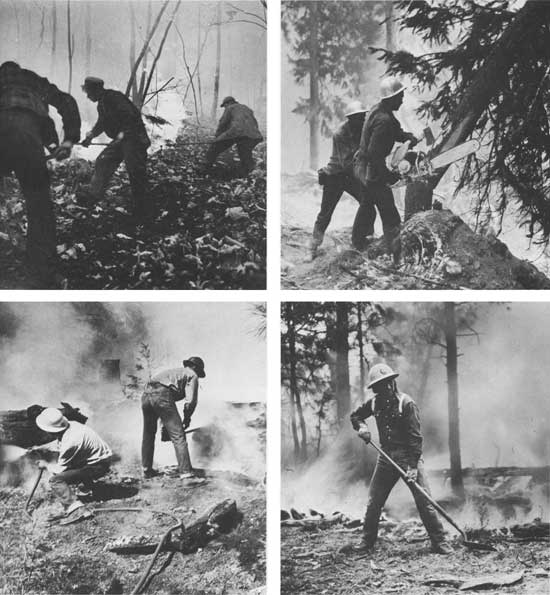
|
|
In controlling forest fires and putting them "dead out,"
there will always be need for the "ground troops." 1 (top left). Building a
fireline (Cherokee National Forest, Tennessee, 1952). (F—471196) 2 (bottom left). Mopup
operation using a fog nozzle (Lolo National Forest, Montana, 1953). (F—471680) 3 (top
right). Power saws made it easier to fell trees along the fireline (Lolo
National Forest, Montana, 1953). (F—473678) 4 (bottom right). The Forest Service has
employed American Indian firefighting crews for many years to help battle
wildfires in the West and elsewhere. Several Indian reservations have set
up training programs and firefighting organizations where skills and endurance
necessary for good firefighting crews are developed. This Santo Domingo,
New Mexico, firefighter was busy on the Sitgreaves National Forest, Arizona,
in 1956. (F—522358)
|

|
|
1 (top). It was in 1950 when 4-year-old Judy Bell, daughter
of a New Mexico Game Warden, helped nurse back to health a badly burned brown
bear cub, after he was rescued from a forest fire on the Lincoln National
Forest near Capitan, New Mexico. The cub was destined to attain fame as the
living symbol of Smokey Bear. (Forest Service Cooperative Fire Protection) 2 (bottom). On the 100th anniversary of the
birth of President Theodore Roosevelt, May 8, 1958, President Dwight D.
Eisenhower presented a golden Smokey Bear statuette to Judy Bell in
recognition of the "fine cooperation the children of America have given
forest fire prevention." (N—25468)
|

|
|
1 (top). Smokey Bear's fame and reputation grew, and with it
intensified forest fire prevention efforts on radio, television, in films, and
in the Nation's newspapers and magazines. Popular country singer Eddy Arnold
added his talents to the nationwide program in 1955. (Forest Service Cooperative Fire Protection) 2 (bottom left). It was
5 years after Smokey Bear initially appeared in poster form (1945) that the
living symbol of Smokey Bear from New Mexico took up residence in the Washington,
D.C., National Zoological Gardens. One of his visitors in 1950 was cowboy
star Hopalong Cassidy (Bill Boyd), shown here with Assistant Forest Service
Chief Chris Granger and the little bear. (Forest Service Cooperative Fire Protection) 3 (bottom right). A favorite use of
Smokey Bear has been in the forest, along the forest roads and highways
(Nicolet National Forest, Wisconsin, 1960). (F—495764)
|

|
|
The 5-year program, "Operation Outdoors," launched in 1957,
represented the Forest Service response to a growing public need for improved
and expanded recreation facilities in the National Forests. These public
forests offer a great deal—beauty, space, timeless interest. 1 (top left).
An unusual shot of the George Washington profile on the Mt. Rushmore National
Memorial, Black Hills National Forest, South Dakota (1957). (F—494929) 2 (top center).
Weaver's Needle, in right background, dominates the desolation of the
Superstition Wilderness Area, Tonto National Forest, Arizona (circa 1960). (F—522112)
3 (top right). A magnificent stand of white pine and hemlock at the Laurels
Recreation Area, Cherokee National Forest, Tennessee (1951). (F—469300) 4 (bottom). Auke
Lake upstages the Mendenhall Glacier in the North Tongass National Forest,
near Juneau, Alaska (1956). (F—486775)
|

|
|
1 (top left). Upper Mesa Falls, Targhee National Forest,
Idaho (July 1958). (F—489773) 2 (bottom). That's a rain squall to the east, viewed
from the base of Mt. Withington Fire Tower (elevation 10,297 feet), Cibola
National Forest, New Mexico (August 1960). (F—497795)
|

|
|
1 (top left). The Sierra Crest and the Palisade Glaciers
(southernmost glaciers in the United States) are an inspiring sight when viewed
across Summit Lake. Peaks in the Crest are all close to 14,000 feet high
(Inyo National Forest, California, July 1958). (F—487498) 2 (bottom). Buck Mountain Lookout
(elevation 4,768 feet) and the Blue River Lookout and McRae Creek Drainages
in the Willamette National Forest, Oregon (1960). (F—505566)
|

|
|
Something for everyone—for the sightseers, strollers, hikers,
and riders . . . 1 (top left). Famed mining town of the last century, Silverton,
Colorado, had become practically a ghost town by 1957. It has since experienced
a considerable revival as a tourist town. McComber Mountain, in the background,
is one of the many 12,000- to 13,000-foot peaks that surround the town (San Juan
National Forest, Colorado). (F—484582) 2 (bottom left). The Sosbee Cove stand of yellow poplar
in the Chattahoochee National Forest, Georgia, was set aside by the Forest Service
as a memorial to Forest Ranger Arthur Woody (1957, see page 104). (F—499683) 3 (top right).
High Sierra Wilderness hikers admired this view of the Palisade Glaciers (Inyo
National Forest, California, 1958). (F—487504) 4 (bottom right). Packing into the Pecos
Wilderness Area, Santa Fe National Forest, New Mexico (1957). (F—492916)
|
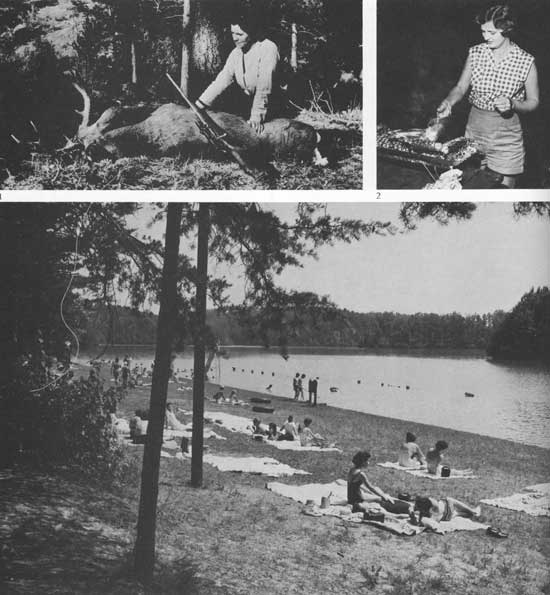
|
|
. . . for the outdoor cooks, swimmers and sun bathers, old
shavers, and the hunters. 1 (top left). This mule deer dressed out at 210 pounds
(Roosevelt National Forest, Colorado, October 1950). (F—465693) 2 (top right). Steak and
roasting ears, Jefferson National Forest, Virginia (1958). (F—487159) 3 (bottom). Sun and
water at Lake Russell, named for Georgia's venerable statesman, the late Senator
Richard Russell, Chattahoochee National Forest (1959). (F—494721)
|

|
|
1. A chore, not regularly done, during the 10-day American
Forestry Association Trail Riders Canoe Trip in the Boundary Waters Canoe
Area, Superior National Forest, Minnesota (1948). (F—451830)
|
aib-402/sec4.htm
Last Updated: 12-May-2008
|



































